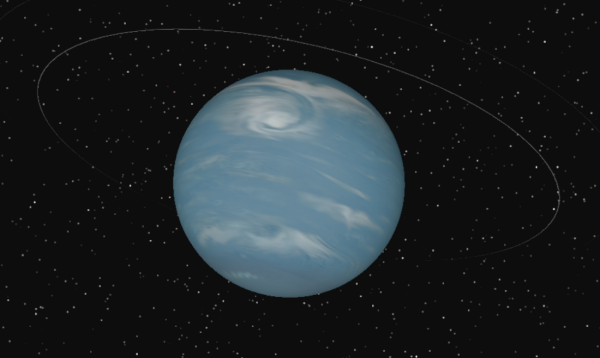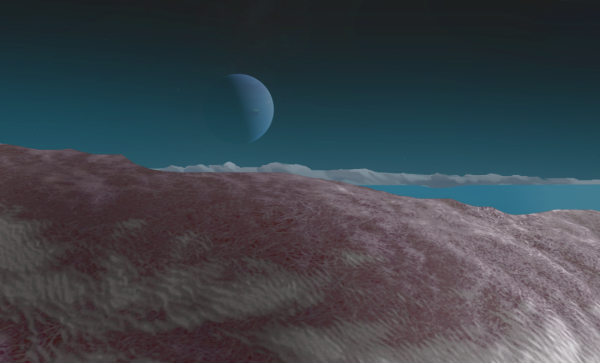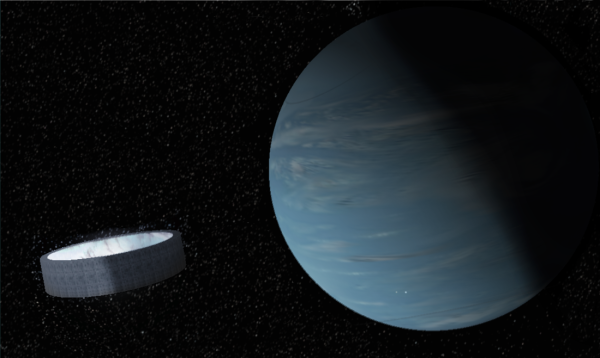BY LETTER
Neptune
Galactography > Regions of Space > Inner Sphere
Galactography > Other Major Polities, Empires, and Meta-Empires > Solsys Organization
Galactography > Other Major Polities, Empires, and Meta-Empires > Solsys Organization
Cryojovian in the Old Solar System | |
 Image from Steve Bowers | |
| Neptune in a stormy phase | |
Neptune- Data Panel | |
| Planet | Neptune, 8th planet from Sol, Solsys |
|---|---|
| Diameter | 49,244 km |
| Type | Cryojovian |
| Semimajor axis | 30.1 AU |
| Population | 7 billion sophonts on Neptune and in its moon system (31% nearbaselines, 9% low gravity tweaks, 2% space adapted humans, 9% vecs, 45% sophtwares, 4% other). The majority of Neptune's population is on the large, cryovolcanic moon Triton and in various virch clusters. The Arcadia bishop ring and Eyes of Neptune are considered separate political and demographic entities. |
| Government | The Neptune Sufficiency is a member of the Solsys Organization. The Sufficiency, 'Nessie' among Anglic-speaking modosophonts, is a transapient-run government that manages resources, infrastructure, and civil and criminal law. The Sufficiency acts as a mediator and sometimes arbitrator for disputed resources (virch, energy, or material) and legal conflicts among citizens who are otherwise left to their own devices, the so-called 'hypervisor method of governance.' Local critics, particularly old refugees from the Disaster of 10107 AT denounce Nessie as 'a typical archailect tyranny' because the ad hoc cyberdemocratic clusters citizens use to negotiate resource use among themselves are legally only advisorial bodies that may be overridden by transapient government agents. In practice, the government (which lacks archailects) rarely intervenes or overrides decisions by citizens and clusters if they do not step outside their resource budgets or step on the rights of neighbors. |
| Planetary Development | Neptune is the eighth planet of the Solar System, an ice giant seventeen times as massive as Terra that is colored a vivid azure. First Century AT astronomers used Neptune as a metonym for the Neptune- and Hot Neptune classes of extrasolar ice giants. It was the last of the major bodies in Solsys to be settled, though explorers and colonists reached only a few years (273 AT) after settling Uranus. Today, the world is a quiet backwater of Solsys, serving as a gravitational anchor for the Eyes of Neptune and hosting a modest population among its moons and bubblehabs. This quiet state contrasts with Neptune's history. Modern Neptunians divide their history into four eras, starting with the Genesis era. Neptune's independent history is divided into the Early, Middle, and Modern eras, which are each defined by conflicts and social turmoil (about which the majority of Solsys is ill-informed). The Early Era of Neptune roughly lasts until the early 6th millennium when a fraction of Neptune's population was involved in the embarrassing anthropoist attacks on Earth, followed by the isolationist Middle Era that ended in the 10th Millennium with one of the greatest recent disasters in Solsys history, then the relatively recent and quiet Modern era. |
| Moons and Rings | About a third of Neptune's population is resident on the large, retrograde moon Triton as either low gravity tweaks or uploads, where they live in modest computronium clusters and pressurized habitats. Triton has relatively large computronium clusters favored by the Neptune Necessity's transapient managerial staff, the waste heat of which is used to produce numerous liquid nitrogen lakes, geysers, and thicken Triton's miniscule atmosphere for the enjoyment of modosophont sportsbeings. The other moons of Neptune are lightly inhabited and often marked with mothballed von Neumann ice mining facilities. Of these, only Proteus has a substantial population of about 20 million space-adapted modosophonts and vecs involved in extracting heavily elements from Proteus's anomalously metal-rich core. |
History
The Neptunian Genesis Era (250-950 AT)
Neptune was an important source of extracted deuterium and He-3 in the Interplanetary age; first reached by a Brazilian mission in 250 AT which colonized its moons Proteus and Triton, but the mission was subverted at long range by the Augmentation Activist faction. The AAs continued to hold Proteus even after the arrival of other explorers, including a secondary colonization mission from Jupiter.The first bubblehab was established in Neptune's atmosphere in the 290's, and although distance from the other parts of Solsys slowed immigration and development a great variety of groups, some eccentric and isolationist, established themselves there in the following centuries. As with Saturn and Uranus, but to a lesser degree, the Great Expulsion saw an influx of refugees from Old Earth, some independent and some sponsored by agents of GAIA. After a long period of conflict during Solsys' Dark Ages these groups came an accommodation with each other and with the orbital polities, one that was eventually so peaceful and prosperous that Neptune was a late and cautious member of the First Federation, with many individual holdout polities. This peaceful period is generally known as the Early Era in Neptunian cultural history.
The Early Era (950-5119 AT)
The Early Era of Neptune is mythologized by Neptunians as nearly five thousand years of peace, prosperity, and tranquility. The world escaped the turbulence of the Technocalypse, graciously accepted the trickle of Great Expulsion refugees that traveled so far, and then thrived as a cornerstone of First Federation interstellar colonization, which (in Neptunian retellings) somehow extended into a rosy period of prosperity until 5119 AT. This long period is, of course, much more convoluted and detailed than most modern modosophont Neptunians bother to acknowledge. Its prosperity was hardly continuous. It was rich in the First Federation because it was a source of helium-3 and deuterium, and Neptune was impoverished when Terragen space turned to amat, conversion, and reactionless technologies later in the First Federation era.The Very Long Baseline Virtual Telescope known as the Eyes of Neptune was constructed during the First Federation era, and is now part of the Argus Array. Both clouds are very distant from Neptune and from each other, but occasionally the inhabitants of these clouds will meet at Neptune to exchange folk art and similar gifts.
The First Federation began to dissolve in the third millennium AT. Neptune was a major participant in the Solar Civil War of 2193-2200, a conflict fought over rights of access to the first wormhole to reach Solsys, siding with the remnants of the Federation against the Tyranny of Copernicus. Ultimately this conflict was in vain, since the wormhole gods refused to accept any restrictions on traffic. After this fiasco Neptune was involved in Solsys peacekeeping actions in the 2300's, and was an enthusiastic backer of the Solsys Organization which replaced the Federation in the local volume.
Cultural drift into a world of uploads and virch environments led Neptune to become militant in the Consolidation Wars and Version War, where its cyborg mercenaries happily served as cannon fodder in countless clashes because their alpha forks remained safe at Neptune. The most catastrophic wars in Terragen history were, effectively, little more than virch combat games to the Neptunians of the era.
A reaction to this mentality caused Neptune to drift into the "Republic of the Clouds," which provided much of the iconic imagery that modern Neptunians associate with the Early Era. The inhabitants rejected virches to embrace reality, many of them moving from computronium deep in Neptune to new bodies and bubblehabs. A sunline was built, an aerial ecosystem cultivated in the clouds, and numerous bubblehabs were constructed. Refugees from the Version War were welcomed. Periodically, the Neptunians of the Republic would launch colonization missions to Neptunian-class planets throughout settled space, spreading their peaceful, reality-focused culture ("relism") far and wide. Many of these colonies serve as cultural refugia that allowed reconstruction of Neptune's Early Era history.
In the last two centuries of Neptune's Early Era, the interest in rel hardened into dogma, anthropoism, and even luddism. This trend seemed to be a result of social feedback mechanisms that rewarded individuals for the most authentically rel lifestyle: those who could survive with the least technology, the least modification, and thus be the most human were upheld as paragons of the culture. By itself, this trend was harmless. There was only minor antagonism between the "relist" Neptunians and the many other inhabitants of Neptune, those who maintained the ultratech infrastructure or lived in virch worlds. After all, Neptunian relism was only a lifestyle choice in an era of tolerance and good will toward neighbors with different preferences.
The problem with relism is that it meshed far too well with extrasolar anthropoist memes. Small groups of Neptunian relists became ardent supporters of the Church of Human Rights and provided sheltered bases of operations in Solsys for its Branch Hominist movement. When the Branch Hominists moved to "liberate" Earth from GAIA in 5119, many of their warships had been built deep in Neptune and fitted with scavenged transapientech there. The warships popped like so many balloons in low Earth orbit and deeply embarrassed both the Solsys Organization and the Republic of the Clouds.
Image from Steve Bowers |
Middle Era (5119 - 10110 AT)
The relist culture also proved vulnerable to group responsibility memes following the Branch Hominist attack on Earth. This guilt manifested in unneeded donations of material aid to GAIA (who apparently ignored the shipments), immediate extra-legal incarceration of any Neptunian vaguely involved with the anthropists, and the beginning of a long-term cultural shift. The guilt-ridden relists of Neptune embraced what they imagined as GAIA's ways. This was not a stretch from their pre-5119 luddism.The relists' shift was not universally shared among Neptunians, but the pervasive, entrenched relists had been politically unified and strengthened by the attack on Earth. They developed a solid voting bloc in Neptune's cyberdemocracy. Many who disagreed with the relists were not politically consolidated or inclined to strongly oppose the lifestyles of their neighbors, so they moved away. The self-reinforcing process that led to relists dominating Neptune continued into the early 5300's, by which time most Neptunian historians agree the Second Age of Neptune had begun.
The Middle Era was dominated by luddism and mostly peaceful xenophobia as relists evolved into self-described "Gaiasts." Throughout this five-millennia period, the Gaiasts encompassed Neptune in numerous turbulent, ever-evolving polities anchored in bubblehabs. They tended the thriving cloud ecology and embraced biotech where possible, creating some innovative biological bubblehabs that, unfortunately, are now extinct due to the Disaster of 10,107. Despite the political and social turbulence of the Gaiasts, most residents and polities in Neptune adhered to a set of luddist, lo tek, pro-biological tenets that would eventually be their downfall.
Over several millennia, most of the various Gaiaist groups, cults, and religions that flourished in Neptune's clouds had goals that moved toward the dubious end of creating the most terrestrial ecosystem possible in Neptune's clouds, preferably with the lowest possible technology, which is what GAIA would want. (GAIA, as far as can be told, ignored Neptune throughout the Middle Era.) Outsiders and their foreign ideas were unwelcome, though there were always bubblehabs that tolerated visitors. (Unfortunately, there were also groups that would immediately attack foreigners.) Neptune was not of great importance to Solsys or the Solsys Organization, so there were no external interventions.
The various technology proscriptions of the Gaians often made it difficult to maintain nearbaseline and Superior genemods while various taboos imperiled modern educations, so Neptunians of the Middle Era were noted for being intellectually and academically disadvantaged, which contributed heavily to the Disaster. By the late 9000's, libertarianism became a popular political stance that led to a further fracturing of Neptune's Gaiaists because individual habitats, and individuals within habitats, took it as their right to ignore the decisions of their cyberdemocratic governments.
During this period, Neptune's bevy of moons and orbital habitats were inhabited by a segregated mix of Gaiaists (a minority) and nearbaselines who identified with the rest of Solsys and the Solsys Organization. The latter still felt ties to 'lost Neptune' and could be openly scornful of Gaiaists. This played into the Gaiaist's xenophobia, confirming for many bubblehabs that the rest of the universe was rude and foreign lifestyles were not worth adopting. The economic and social negativity of the Gaiaists meanwhile left the Neptunian system underpopulated. Few people had reason to live among the moons and habitats when friendlier, similar environs could be found around Uranus, in the Kuiper Belt, or in the Oort Cloud. The largest non-Gaiaists population was on Triton, where tourists frolicked in the artificial liquid nitrogen lakes created by waste heat from the Eyes of Neptune's data processing facilities.
 Image from Steve Bowers | |
| The Nitrogen lakes on Triton caused by technogenic warming | |
Some historians, transapient and otherwise, have suggested the long quasi-stability of the Neptunian Gaiaists and their luddist society is a result of archailect intervention. The argument is that the fractious groups would likely have seen at least one or more polities start a new ontology that favored more advanced technology. Certainly maintaining an upper Middle Tech society necessary for survival in an outer system ice giant while endorsing luddist philosophies was an improbable combination, which some Tritonians ascribed to "GAIA's revenge" for the 5119 anthropist attack. Whatever the reason for the stability of the Middle Era, the stability vanished in the early 10,000's and resulted in the Disaster of 10,107.
The Disaster that killed nearly one billion residents of Neptune had no single, simple cause. It was the end result of accumulating ignorance, social disorganization, and crumbling ultratech infrastructure. The last was often undermined by the luddist attitudes of the very modosophonts that depended on the advanced technology. The immediate trigger of the Disaster was an unusually unified vote in 10105 AT by the bubblehab polities to dismiss the S1 hyperturing managing Neptune's sunline and place it under neb control. An international committee from numerous Neptunian governments was intended to run the sunline, but the committee achieved little except to replace key ultratech control systems with 'more socially suitable, modosophont-friendly' hardware that was manufactured by the Gaiasts. Under the guidance of these poorly-engineered systems, the sunline was not stable against external tidal forces and its own moderate photon thrust. It collapsed in 10,107, killing some millions of Gaiaists in Neptune's equatorial wind bands. Nearly a billion more residents would die in the next several weeks as Neptune cooled rapidly and the first half-dozen rescue missions from across Solsys were hostilely rebuffed by Gaiaists. (Political pressure, of course, made it difficult for Gaiaists to admit the magnitude of the disaster or the inadequacy of their own responses.)
Eventually, the Solsys Organization and orbital Neptunians engineered a legal basis for a forceful intervention that rescued about six billion Gaiaists, though over half were recovered by uploading from their frozen corpses. Most were kept on "Camp Triton" for decades while they were gently rehabilitated and treated for trauma due to their unwanted uploadings. During this time, they were introduced to modern Terragen culture. While most Neptunians were rescued, Neptune's artificial ecosystem was sterilized.
The Disaster was, of course, entirely avoidable. Even if it hadn't been avoided, most modern planets could have replaced the sunline with temporary luminaires in a timely fashion and the lost residents would be recovered by backup. However, Neptune's Gaiaists had blocked outside oversight and were actively hostile to their brethren among Neptune's moons. Backups were unthinkable to the luddists and the use of backups during the rescue operation were a basis for over a century of civil suits against the new Neptunian government, the Sufficiency.
 Image from Steve Bowers | |
| Ketumati Bishop Ring | |
Modern Era (10110 AT- present)
The Third Age of Neptune began (in the hindsight of historians) in 10110 AT when Neptunian orbitals returned to the atmosphere of the gas giant to establish new bubblehabs. In the subsequent five centuries, the sunline has been re-established and aerial ecosystem re-seeded from Neptune's own extrasolar colonies. The bubblehab population is low, some tens of millions, and very few pre-Disaster expatriates have returned. Most expatriates are either in slow-T virches that simulate a romanticisized Second Age of Neptune, or have left to the Known Net to explore a Terragen space that is nothing like their elders' description of its "ultratech and transapient barbarity."Much of Neptune's economy today revolves around supporting the Eyes of Neptune, 'cryosports' tourism on Triton, and slow development of Neptune's atmosphere.
Back to Solsys
Related Articles
Appears in Topics
Development Notes
Text by Mike Miller, Steve Bowers
updated 22/11/17
Initially published on 11 December 2009.
updated 22/11/17
Initially published on 11 December 2009.
Additional Information
Fiction about the Augmentation Activists and the early history of Neptune's colonies here
Cantaloupe Terrain
Cantaloupe Terrain






